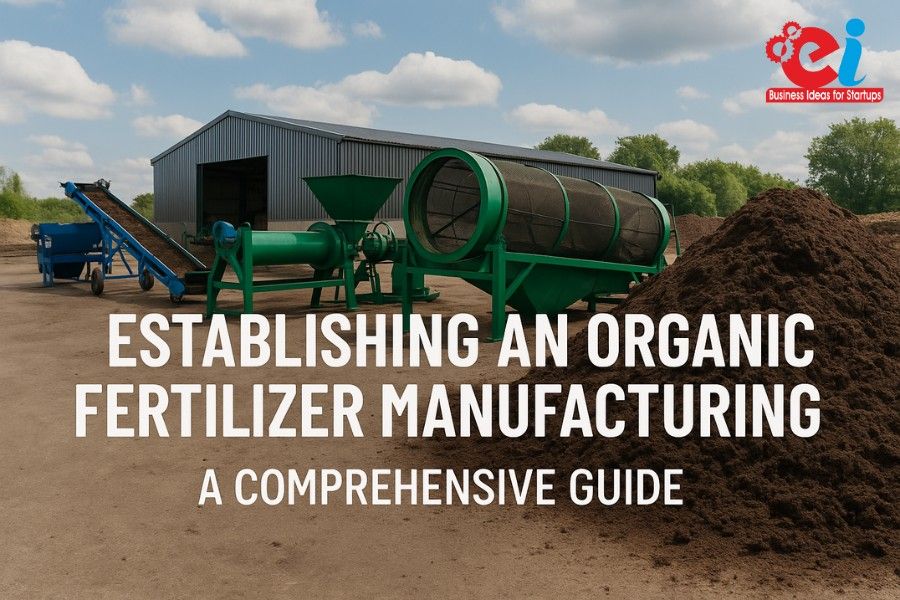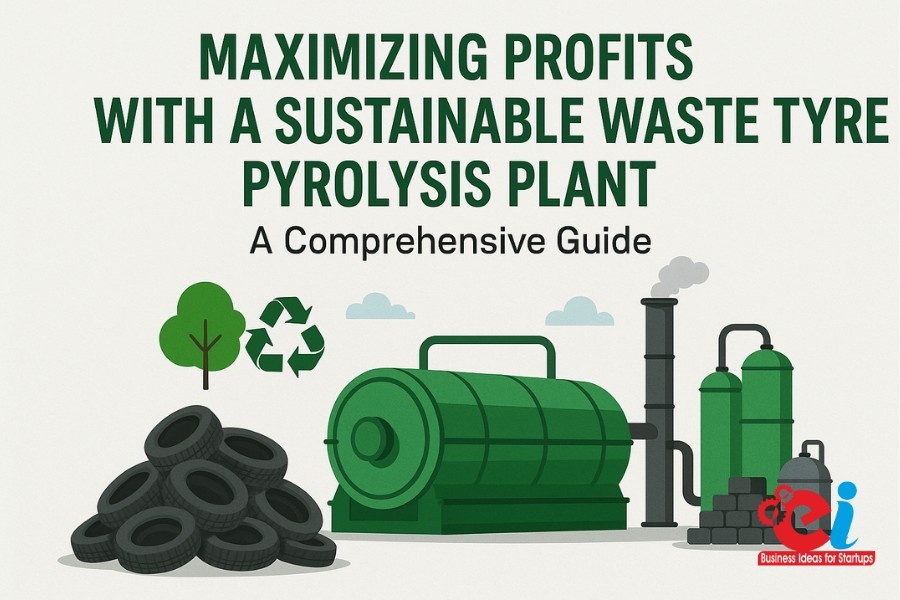The increase in eco-friendly and sustainable approaches to agriculture has paved the way for Organic Fertilizer Manufacturing, which help rejuvenate the soil and increase crop yields in an environmentally friendly manner. There is a growing need for fertilizers as India progresses towards natural farming with initiatives such as Paramparagat Krishi Vikas Yojana (PKVY) and Zero Budget Natural Farming (ZBNF). This allows entrepreneurship because establishing an Organic Fertilizer Manufacturing plant not only assures profits but contributes towards a greener and cleaner India.
This guide is for all agri-entrepreneurs, startups, and cooperatives, and aims to answer questions related to setting up an organic fertilizers unit, ranging from selecting the correct raw materials and understanding the Organic Fertilizer Manufacturing process and licenses needed, to the market demand, and how NIIR Project Consultancy Services (NPCS) aids in making your venture successful.
1. What is Organic Fertilizer?
Organic fertilizers are made from natural substances like animal dung, plant remains, or even biowaste. They help in enriching the soil by potentiating the level of nitrogen, phosphorus, and potassium as well as improving soil retention and encouraging microbial activities, all without infusing harmful chemicals that come with synthetic fertilizers.
Categories of Organic Fertilizers:
| Classification | Source Material |
| Vermicomposting | Food waste, farm waste, and cow manure |
| (Aerobic/Anaerobic) Composting | Municipal and kitchen waste |
| Bio-fertilizers | Nitrogen-fixing Azospirillum bacteria |
| Green Legume Manure | Plants such as dhaincha and sunhemp |
| Organic Manure | Goat dung, chicken litter, and cow excrement |
| Fish/Seaweed Emulsion | Extracted from seaweed and marine waste |
2. Market Scope for Organic Fertilizer Manufacturing
Increase in Demand From:
- Adoption of chemical-free farming practices
- Organic foods are being exported more
- Encouragement of organic farming by the government
- Widespread soil degradation from chemical fertilizers
Market Trends:
- Between 2023 to 2030, the Indian market for organic fertilizers is estimated to expand by 11% CAGR
- Consumer preference for organic produce leads to farmers adopting organic methods
- There is an increasing international market from Southeast Asia, the Middle East, and Europe
📌 NPCS: NIIR Project Consultancy Services provides detailed feasibility studies focused on national and international demand, export opportunities, and specific farming activities in the region.
Related: How to Start Biofertilizer Manufacturing Business and Organic Farming?
3. Selecting an Appropriate Business Model
| Business Model | Target Customers | Primary Activities |
| Vermicompost Production | SHGs, Small farmers | Worm breeding, bagging, and composting |
| Municipal Waste Compost Plant | Urban NGOs, Entrepreneurs | Composting, sorting, and compost screening |
| Commercial Manure Processing | Large or mid-size businesses | Sourcing and drying manure for granulation |
| Liquid Organic Fertilizer Unit | Agriculture input companies | Fermentation and bottling of filters |
NPCS aids in model selection considering budget, area, and raw material proximity.
4. Land and Infrastructure Requirements
Area of Land:
| Capacity | Land Area |
| Small (1 TPD) | 1,500 – 3,000 sq. ft. |
| Medium (5-10 TPD) | 0.5─1 acre |
| Large (>20 TPD) | 2─5 acres |
Infrastructure Components:
- Sheds for storage of raw composting materials
- Composting beds or windrow systems
- Vermi tanks or bioreactors
- Currugated belt screening and hand-potting area
- Packing area (manual/semi-automated)
- Office and laboratory (for quality assurance testing)
📌 NPCS lends a helping hand by providing plant layouts and equipment placement schematics tailored to optimize functional workflows.
5. Document Collection for Organic Fertilizer
Principal Ingredients:
- Dairy byproducts like cow dung, poultry litter, goat manure
- Agricultural waste such as straw, husk, and chaff
- Kitchen and food leftovers
- Waste byproducts of the sugar industry including press mud and molasses
- Horticultural byproducts
- Specialty fertilizers made from fish waste or seaweed
Residual Sources:
- Farms including Dairy and Poultry
- Food processing centers
- Municipal solid waste, once it’s segregated
- Generators of organic waste
✅ Strong networks with local farmers, municipalities, and cooperatives help sustain consistent supplier raw materials.
Observe local regulations and environmental laws, collect nutrients, blend, and package.
Related: India’s Agriculture Sector: Its Role in Government Initiatives
6. Organic Fertilizer Manufacturing Process
Vermicomposting Process (Most Common):
- Pre-treatment of Waste
- If necessary, raw material is dessicated and shredded.
- If necessary, raw material is dessicated and shredded.
- Preparation of Composting Bed
- Earthworms (Eisenia fetida) are added to the bedding material mixture of cow dung and agri waste.
- Earthworms (Eisenia fetida) are added to the bedding material mixture of cow dung and agri waste.
- Decomposition Phase
- Earthworms break down organic waste and excrete nutrient-rich castings.
- Earthworms break down organic waste and excrete nutrient-rich castings.
- Harvesting
- Compost is harvested after 45 to 60 days.
- Compost is harvested after 45 to 60 days.
- Offsetting and Drying
- Material is sieved to remove lumps and dried naturally or using hot air.
- Material is sieved to remove lumps and dried naturally or using hot air.
- Packaging
- Done in small pouches or 25–50 kg consumer-size bags.
- Done in small pouches or 25–50 kg consumer-size bags.
Auxiliary Best Practices:
- Aerobic Composting in Windrows: Manual stirring, followed by machine-aided composting
- Aerobic Digestion of Biogas Digestate: Can be used directly without cleansing
- Microbial Fertilizer Production: Via liquid fermentation units
📘 NPCS provides comprehensive charts, SOPs, and equipment guidance.
7. List of Instruments and Other Tools
| Equipment/Tools | Purpose | Price (INR) |
| Shredder/Crusher | Size Reduction of Organic Matter | ₹1–3 Lakhs |
| Compost Turner/Loader | Aeration and turning of compost | ₹3–6 Lakhs |
| Vermi Tanks or Beds | Habitat for worms | ₹1–2 Lakhs |
| Screening Machine | Stone/lumps removal | ₹1–2 Lakhs |
| Dryer (optional) | Moisture removal | ₹3–5 Lakhs |
| Bag Sealing & Packing | End-of-line packing automation | ₹2–3 Lakhs |
💰 Total estimated cost for a partially automated system: ₹15–30 Lakhs
8. Legal Requirements and Certifications
Required Licenses:
- Company Registration (MSME/Udyam)
- License under FCO (Fertilizer Control Order), 1985
- Pollution NOC – State Pollution Control Board
- Factory License – for larger units
- GST Registration
Voluntary Accreditations:
- ISI/BIS Mark – for specific fertilizer types
- Organic Certification – APEDA/NPOP (for export)
- ISO 9001/14001 – Quality & Environment Management
📑 NPCS assists with license applications, legal documents, and QC frameworks.
9. Financial Feasibility and Scope of Earnings
Expected Investment:
| Element | Cost Estimation (INR) |
| Land and Building | ₹10–15 Lakhs |
| Plants and Machinery | ₹15–30 Lakhs |
| License and Registration Fees | ₹2–3 Lakhs |
| Working Capital (3 Months) | ₹10–12 Lakhs |
| Advertisement & Brand Promotion | ₹2–5 Lakhs |
| Grand Total | ₹40–60 Lakhs |
Income Projection (5 TPD Plant):
- Monthly Production: 120–130 MT
- Selling Price: ₹5–8 per kg
- Monthly Revenue: ₹6–10 Lakhs
- Gross Profit Margin: 30–40%
- ROI: 28–35%
- Break-even: 18–24 months
📘 NPCS prepares P&L accounts, ROI models, and subvention analysis.
10. Subsidies Provided by the Government and Additional Aids
Key Schemes:
- PKVY – Grants for organic farming projects
- CISS (Capital Investment Subsidy Scheme) – 25% subsidy for compost plant setup
- PMEGP Loans – Loans with 15–35% subsidy for MSMEs
- Startup India Seed Fund – Support for sustainability-driven agritech ventures
📌 NPCS prepares DPRs and documents required for claiming subsidies from central/state agencies.
11. The Assistance NPCS Provides
NIIR Project Consultancy Services (NPCS) offers support from concept to commissioning:
- DPRs and financial documentation
- Market surveys and demand forecasts
- Sourcing strategies for raw materials
- Machinery list, layout design, and supplier guidance
- Licensing, certifications, and quality control
- Grant/fundraising assistance and subsidy applications
📞 Contact: +91-9097075054
📧 Email: npcs.ei@gmail.com
🌐 Website: www.entrepreneurindia.co
To Summarize
The Organic Fertilizer Manufacturing plant allows a business to become successful while also fulfilling its need to safeguard the environment. Coupled with natural fertilizers and encouraging government policies, this part of the economy has a promising outlook in the long run.
Entrepreneurs looking to leverage the guide will be thrilled to know NPCS will assist in the aid of developing a turnkey scalable business unit which will empower generations to come for a pollution-free India.
Put your funds in nurturing nature, improving soil quality, and watching your business grow organically.

























